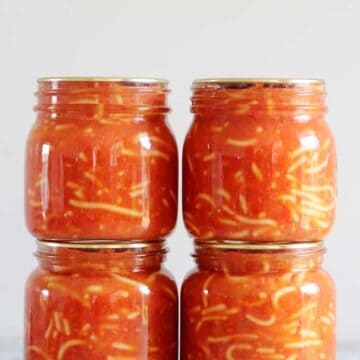
Homemade Bottled Spaghetti
If you love canned spaghetti, you need to know how to make it at home. Here is our family recipe, with step by step photos and instructions!
Print
Pin
Servings: 12 500ml jars
Ingredients
- 5.5 kg tomatoes
- 3 onions
- 500 grams dry spaghetti
- 2 Tablespoons plain salt (not iodised)
- 2 Tablespoons sugar
Instructions
Step 1: Sterilise your jars and wash lids/seals
- 2 hours before you need the jars, run them through the dishwasher on the hottest wash (ours is called hygiene but it may be called sterilise on your machine) Keep the door shut until you are ready for the jars as it will keep them warm until you are ready to use them. If you don’t have a dishwasher, wash the jars thoroughly in hot soapy water and place them in the oven at 150°C for at least 15 minutes or until you need them.Wash the lids and seals in warm soapy water. We usually place the seals in a bowl and cover them with boiling water until we are ready to use them.
Step 2: Wash and prepare the tomatoes and onions
- Put the tomatoes in the clean sink, fill it with water and give them a quick wipe down. Inspect the tomatoes for any blemishes that need to be cut out.After washing them, chop them into a halves or quarters and place them in a food processor. Blitz them until they are sauce like and pour into a large (the biggest one you have!) stockpot on the stove. While you are blitzing the tomatoes, add the onions to the mix too and blitz them up as well.Once all the tomatoes and onions are in the pot, bring it to the boil. This can take a while so we usually have the heat turned on as we are adding tomatoes. This speeds up the process slightly. Once the mixture is at a rolling boil, cook for 15 minutes.
Step 3: Cook the spaghetti
- Bring a pot of water to the boil (don’t add any salt) and cook the spaghetti for 10 minutes. Drain when cooked.
Step 4: Mix it all together
- Add the drained spaghetti to the tomato and onion mixture along with the salt and sugar. Mix it together and bring it back to the boil. Once it is boiling, cook for a further 30 minutes. At this stage, you will need to babysit the spaghetti. It can catch on the bottom of the pan pretty easily, so it’s worth taking the time to stir it constantly. Once it has finished cooking, take the pot off the heat while you are filling the jars.
Step 5: Put it into jars (the overflow method)
- Remember that the jars need to be hot when adding the hot spaghetti, so we like to work 2 at a time, pulling them out of the oven or dishwasher and adding the spaghetti.Fill a plastic jug with some of the spaghetti mixture. Use the ladle to pour the spaghetti into jars (using the funnel to guide it if you have one). You want to fill them until the spaghetti is as close to the top as you can get it, without it spilling over the rim of the jar. Run a clean spatula or chopstick around the inside of the jar to remove any air bubbles.Using a clean damp cloth, wipe around the rim of the jar to remove any juice or seeds and if needed, top up the jar with a splash of boiling water to get the liquid right to the top.Carefully place a seal on the jar and screw the ring/lid on tightly. Place the jar to the side and move on to the next one. You’re done!
Step 5: Put it into jars (the water bath method)
- Fill your biggest stock pot with enough water to submerge the jars and cover them with at least 3cm of water and bring it to the boil. You will need to place a clean tea towel or wire rack on the bottom so that the jars are not in direct contact with the pot.Before filling the jars add ¼ teaspoon of citric acid to the jar. Continue to fill the jars with spaghetti, leaving a 1.2cm a gap at the top. Run a clean spatula or chopstick around the inside of the jar to remove any air bubbles. Place the seal on the jar and screw on the lid/band until just tight.Place the jars into the boiling water (a set of jar tongs is a super useful tool here) and once all jars are in the pot, bring it back to the boil and process the jars for 90 minutes. Once that time is up, turn off the heat and leave the jars in the water for a further 5 minutes before removing them from the water.
Step 6: Checking the seals
- Once the jars have been processed, leave them sitting on the bench overnight. In the morning, check the seals. Remove the rings from the jars and if they have sealed, the seal will be concave and you won’t be able to prise it off using your finger. If the jar has sealed, give the jar a clean with a damp cloth and store in a cool dark place. Properly sealed jars will keep for at least a year.If the jars haven’t sealed they cannot be stored at room temperature but they are still safe to eat. Just place the jar in the fridge and eat within a week. Alternatively, you could transfer the contents of the jar to a freezer proof container and store it in there.
Tried this Recipe? Tag me Today!Tag @thekiwicountrygirl or tag #thekiwicountrygirl!